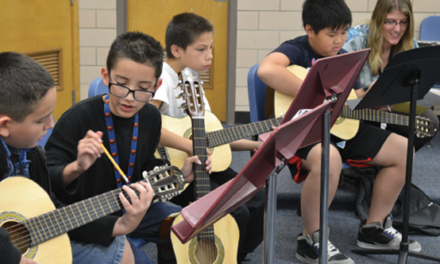The piling on of demands during the pandemic increased teacher stress. How can leaders reduce demands and increase resources now and in the future?

Getty Images
In 2019, half of teachers surveyed in the PDK Poll reported that they were considering leaving the profession, most commonly because of low pay and high stress (PDK International, 2019). The COVID-19 pandemic has made matters worse by adding demands on teachers, thus increasing their stress. Educators were forced to switch to online teaching in spring 2020. And as schools reopened and variants proliferated, many felt their schools’ masking and vaccination policies did not sufficiently protect them (Hamilton & Ercikan, 2021; Pressley & Ha, 2021). Even as the pandemic begins to (hopefully) recede, teachers have to catch students up on meeting educational benchmarks and address widened inequities in educational outcomes for minoritized students and those from lower-income communities (Curriculum Associates, 2021).
There is hope. Winston Churchill famously remarked, “Never let a good crisis go to waste” when working to establish the United Nations after World War II. A silver lining from COVID-19 could come from the research on teacher stress during the pandemic, which suggests ways to better support teachers going forward. To understand how teacher stress is defined, how the pandemic exacerbated stress, and what can be done to alleviate stress and promote wellness, we can turn to several sources. One source is the literature on teacher stress published before and during the pandemic. Another is our research team’s investigation of the impacts of COVID on teachers in a school district in Central Texas in the 2020-21 school year (http://sites.edb.utexas.edu/copingandstress). Finally, we can see the findings from contributors to our forthcoming edited book Research on Stress and Coping in K-12 Education: Implications for the COVID-19 Pandemic and Beyond (McCarthy & Lambert, in press).
What is teacher stress?
Stress affects teachers’ occupational health in numerous ways, including by increasing job dissatisfaction and burnout and reducing their commitment to the profession (Jepson & Forrest, 2006; Klassen et al., 2013). Teacher stress can affect campus morale and lead to poor student outcomes (Turner & Theilking, 2019; Will, 2021). Both researchers and the public have taken an increased interest in teacher stress recently, likely in recognition of the many trials and tribulations teachers face (McIntyre, McIntyre, & Francis, 2017). Yet the ubiquitous term stress historically has been used imprecisely. Sometimes people use the term to describe external factors — such as working conditions, which might include demands from school administrators and lack of teacher autonomy (Butt & Retallick, 2002; Gray, 2013). At other times, people are referring to its symptoms — such as burnout (Aloe, Amo, & Shanahan, 2014).
Teacher stress can be understood as occurring when teachers appraise the demands they face as being too high for their resources.
Transactional theory, originally developed by psychologists Richard Lazarus and Susan Folkman (1984), increasingly has become the dominant framework for understanding teacher stress. This model emphasizes a two-step appraisal process (Chang, 2009) that occurs when we encounter potential obstacles and threats in our environment. The process begins with a reflexive primary appraisal about the severity and nature of the threat or demand (“I have to prepare my lesson plan for both online and in-person learning”). It is followed by a secondary appraisal of our resources for addressing the challenge (“I am exhausted, and I am confused about how to use this new technology”). Teacher stress can therefore be understood as occurring when teachers appraise the demands they face as being too high for their resources (Kyriacou, 2001; McCarthy, 2019). When we review the past few years through this lens, we can see how the typical demands and resources associated with being a teacher have changed during the pandemic, leading to greater stress for teachers.
Teacher stress during the pandemic
Teachers were particularly vulnerable these past two years because their energy resources were tied up in coping with new teaching demands that came with the pandemic. The need to introduce new technology into teaching practices with little warning proved overwhelming for many teachers (Chitra, 2020; Fernandez-Batanero et al., 2021). Teachers experienced a greater level of burnout when faced with personal stressors, such as anxiety regarding their health or a loved one’s, job security, and caring for others (Shavers et al., 2022). Seeking to address the needs of their own families as well as of students and their families caused strain for many teachers (Kara, Günes, & Tüysüzer, 2021). Not surprisingly, those who started the pandemic in better health reported lower levels of stress (Oducaso et al., 2021).
Given that more than 80% of classroom teachers are women, one important finding is that women teachers typically reported higher levels of stress than men did during the pandemic (Klapproth et al., 2020). This is perhaps not surprising, given that women still carry a larger share of childcare responsibilities. Women also have seen increases in domestic violence and multiple changes in availability of reproductive health care that added to their stress levels (Dogra & Kaushal, 2022).
The rising tide of stress layered demands on top of demands, reaching traumatic levels for some teachers, overwhelming them beyond their ability to cope emotionally, mentally, or physically (Brencio & Novak, 2019). For example, when winter storm Uri hit Texas in February 2021, many schools closed for more than a week (Texas Education Agency, 2021), and we found in our research that teachers had to shift to survival mode both for themselves and their students, making it impossible to carry out their planned instructional activities (Kelton et al., 2022).
Transactional theory suggests that when demands increase, so must resources. In many cases, new resources for teachers did come as demands rose during the pandemic. School leaders recognized the need to communicate more regularly with their staff, to provide updates on school policy, and to train teachers in technology implementation (Longmuir, 2021). Many teachers began seeing their mentoring relationships with senior teachers as sources of mutual support rather than just apprenticeship (Mosley et al., 2022). Students’ participation in distance learning, while challenging in many ways, also opened new avenues for parental involvement, often leading to improved student engagement (Wilinski, Morley, & Wu, 2022; Yang et al., 2021). Teachers also have seen an increase in support from within their school, from other schools, and within their larger community (Netolicky, 2020). But these resources have not been available or sufficient for all teachers. In some cases, teachers had no choice but to define what they could control, make meaning of their experiences, and resign themselves to the fact that the demands of being a teacher would continue to be overwhelming (Min & Jennings, in press).
Supporting teachers after the pandemic
To provide support for teachers and keep them from becoming and remaining overwhelmed, we must remain attentive to the imbalances in demands and resources that teachers face. Research conducted during the pandemic could shine a light on possible pathways for lessening demands and/or providing additional resources.
Listen to the teachers
Any effort to improve the occupational health of teachers must include teachers’ voices. A familiar theme in our research is that teachers are often not included in discussions about what supports they need (Gearhart, Blaydes, & McCarthy, 2022). This pattern appeared repeatedly in the contributions to our forthcoming book (McCarthy & Lambert, in press). Administrators, policy makers, and researchers often make recommendations and policy decisions without consulting teachers. When one research team, for example, interviewed teachers who were teaching remotely during the pandemic, mostly in high-poverty schools along the California-Mexico border, they reported that they were not asked for their input on the increasing inequities found among students (Levine, Bintliff, & Holtzman, in press).
Teachers are quite capable of identifying the specific resources they need at the individual, campus, district, and community levels. Our research indicates that teachers want more control over the use of their time, more avenues for social support from colleagues and administrators, and designated work-free spaces on campus where they can regroup and recharge. With respect to this last point, teachers also report the need for partnerships with community resources that can help them alleviate stress, such as local gyms and mental health services, at reduced cost (Gearhart, Blaydes, & McCarthy, 2022).
Teachers need care at school
Teaching is a profession full of givers, but the desire to give can lead teachers to work ever harder for others without seeking help for themselves. Direct and indirect messages from school systems and their communities that hail teachers for their heroism and speak of their crucial role in students’ lives can reinforce this tendency in unhealthy ways. Our interviews with teachers before the pandemic showed that teachers want help to mitigate stress and promote their well-being. This might mean encouraging them to set boundaries around break times, assuaging their guilt when they do attend to their own welfare, and enabling teaching teams to support each other (Gearhart, Blaydes, & McCarthy, 2022).
The American School Counselor Association and the National Association of School Psychologists (2021) have jointly appealed to school leaders to provide psychological triage to both students and staff. One way to help is to free school counselors from administrative duties so they can assist teachers in managing stress. Schools and districts also could partner with community resources to increase capacity for referrals to mental health services not just for families and children, but also for teachers. By leaving the teachers out of the conversation about expanded mental health services available through schools, we communicate to teachers that we expect them to be superheroes, capable of enduring whatever conditions come their way.
Teaching is a profession full of givers, but the desire to give can lead teachers to work ever harder for others without seeking help for themselves.
Mentoring relationships also can be further leveraged to support teachers. Interviews our team conducted during the pandemic (Mosley et al., 2022) found that mentoring was very helpful for addressing instructional needs and for social and emotional support. Teachers emphasized the importance of guidance with day-to-day tasks, like lesson planning, from these relationships, as well as mutual support offered when both mentor and mentee had the same struggles, such as challenges implementing new technologies. Formal mentoring efforts could focus not only on learning how to teach, but also on how to lessen demands and build coping resources. When assigning mentors, consider which teachers might be best able to provide support in these areas.
Gratitude goes a long way (but not all the way)
Expressions of gratitude have a variety of positive impacts in the workplace, including promoting a more positive perspective (Watkins et al., 2004); increasing prosocial behavior (Bartlett & DeSteno, 2006); and fostering coping skills (Gordon et al., 2004; Wood, Joseph, & Linley, 2007).
During the pandemic, we asked teachers about their everyday experiences with gratitude (Playfair et al., 2022), and teachers described the benefits of simple yet specific expressions of gratitude, like a student saying thank you after a lesson or receiving recognition in a staff newsletter. Our findings suggest that organized expressions of gratitude from students, colleagues, and administrators can be an effective resource to offset the demands of teaching. However, it is important that gratitude be targeted toward specific ways a teacher was helpful, rather than being a generic appreciation day for all teachers. It was also clear from our interviews that gratitude is not a substitute for more tangible support, such as increased pay.
Give teachers tools for addressing trauma
The pandemic introduced trauma into the educational landscape in a way that many in the current generation of educators had not experienced. High levels of trauma may not disappear with the pandemic, so teachers will need tools to understand and manage it. Members of our research team developed the Mind-Body Group for Teacher Stress (MBGTS; Eyal et al., 2019). In these groups, facilitated by a trained leader, teachers come together, either on campus or virtually, to learn about trauma-related stress, to explore strategies for mitigating stress, and to receive support from one another. Each meeting included a practical skill for lessening stress, such as yogic stretching, scanning one’s body for sources of emotional and physical tension, and focused breathing. Teachers reported finding the sessions useful.
Trauma-informed care (TIC) could also serve as a framework for improving in-service professional development (Dorado et al., 2016). TIC focuses on how trauma and adversity in the world affect people (Champine et al., 2019). By helping people build a community skilled in trust, collaboration, and curiosity, TIC fosters a sense of safety among participants (Chafouleas et al., 2016). TIC programs can vary in content and format; however, they typically include basic information about trauma, such as events that can cause it, as well as how to spot trauma symptoms such as anxiety and hypervigilance — a term that refers to always being on alert for signs of danger (Bassuk, Konnath, & Volk, 2006). TIC programs also emphasize how this knowledge can be translated into skills for supporting students who have themselves experienced trauma. However, implementation has been limited because teachers do not have time to participate in these programs (Parker, Olson, & Bunde, 2019).
TIC training could be particularly useful in teacher induction programs, before educators are beset with the demands of full-time teaching. We piloted a trauma-informed psychoeducational group, which consisted of three virtual sessions, for preservice teachers during the pandemic (Bauer & McCarthy, in press). Participants reported the groups helped them understand the varying responses to experiences of trauma, comprehend the ripple effects of experiences of trauma in their classrooms, and make sense of their previous encounters with trauma.
Getting the profession back in balance
The profession of teaching, already impacted by high demands, low pay, and politicization of their jobs, has been hard hit by the pandemic. Stress not only impacts teachers’ professional capabilities, it also undermines their personal welfare. It remains to be seen how many teachers will decide to enter, or remain, in the profession in upcoming years, but a crisis could be brewing if immediate and concrete steps are not taken to promote the occupational health of teachers (see Marshall et al., 2022, in this issue for more on the potential retention crisis).
As we have noted, teachers did everything they could during the pandemic to help their students academically and personally. We have described a number of promising ways to address their stress, starting with asking teachers themselves what they need. Mentoring, provision of gratitude, and systemic trauma-informed supports also hold promise. Throughout our research during the pandemic, however, teachers sent a consistent message: While such supports are necessary, they are not sufficient to make up for underfunded schools or low pay. Perhaps it is time, in the aftermath of the pandemic, to finally elevate teachers to the status they deserve in terms of compensation, recognition, and professional autonomy. A multifaceted policy response is needed, which both lowers classroom demands for teachers and increases meaningful and useful resources delivered in accessible and actionable ways. We cannot let this crisis go to waste.
References
Aloe, A.M., Amo, L.C., & Shanahan, M.E. (2014). Classroom management self-efficacy and burnout: A multivariate meta-analysis. Educational Psychology Review, 26 (1), 101-126.
American School Counselor Association & National Association of School Psychologists. (2021). School reentry considerations: Supporting student social and emotional learning and mental and behavioral health amidst COVID-19. Authors.
Bartlett, M.Y. & DeSteno, D. (2006). Gratitude and prosocial behavior: Helping when it costs you. Psychological Science, 17 (4), 319-325.
Bassuk, E.L., Konnath, K., & Volk, K.T. (2006). Understanding traumatic stress in children. National Center on Family Homelessness.
Bauer, T.D. & McCarthy, C.J. (in press). Utilizing a psychoeducational group to help teachers understand trauma in the classroom. In C.J. McCarthy & R.G. Lambert (Eds.), Research on stress and coping in K-12 education: implications for the COVID-19 pandemic and beyond. Information Age.
Brencio, F. & Novak, K.D. (2019). The continuum of trauma. D. Schaub et al. (Eds.), In Topography of trauma: Fissures, disruptions, and transfigurations (pp. 11-24). Brill.
Butt, R. & Retallick, J. (2002). Professional well-being and learning: A study of administrator-teacher workplace relationships. The Journal of Educational Enquiry, 3 (1).
Chafouleas, S.M., Johnson, A.H., Overstreet, S., & Santos, N.M. (2016). Toward a blueprint for trauma-informed service delivery in schools. School Mental Health, 8 (1), 144–162.
Champine, R.B., Lang, J.M., Nelson, A.M., Hanson, R.F., & Tebes, J.K. (2019). Systems measures of a trauma-informed approach: A systematic review. American Journal of Community Psychology, 64 (3–4), 418-437.
Chang, M.L. (2009). An appraisal perspective of teacher burnout: Examining the emotional work of teachers. Educational Psychology Review, 21 (3), 193-218.
Chitra, A. (2020). Study on impact of occupational stress on job satisfaction of teachers during COVID-19 pandemic period. Global Development Review, 4 (2), 52-62.
Curriculum Associates. (2021). Understanding student learning: Insights from fall 2021. Author.
Dogra, P. & Kaushal, A. (2022). Underlying the triple burden effects on women educationists due to COVID-19. Education and Information Technologies, 27, 209-228.
Dorado, J.S., Martinez, M., McArthur, L.E., & Leibovitz, T. (2016). Healthy environments and response to trauma in schools (HEARTS): A whole-school, multi-level, prevention and intervention program for creating trauma-informed, safe and supportive Schools. School Mental Health, 8 (1), 163-176.
Eyal, M., Bauer, T., Playfair, E., & McCarthy, C.J. (2019). Mind-body group for teacher stress: A trauma-informed intervention program. The Journal for Specialists in Group Work, 44 (3), 204-221.
Fernandez-Batanero, J., Roman-Gravan, P., Reyes-Rebollo, M., & Montenegro, R.M. (2021). Impact of educational technology on teacher stress and anxiety: A literature review. International Journal of Environmental Research and Public Health, 18 (2), 548.
Gearhart, C.A., Blaydes, M., & McCarthy, C.J. (2022). Barriers to and facilitators for teachers’ well-being. Frontiers in Psychology, 2672.
Gordon, A.K., Muscher-Eizenman, D.R., Holub, S.C., & Dalrymple, J. (2004). What are children thankful for? An archival analysis of gratitude before and after the attacks of September 11. Journal of Applied Developmental Psychology, 25, 531-553.
Gray, P.S. (2013). Factors that impact administrator-teacher relationships [Doctoral dissertation, The University of Southern Mississippi].
Hamilton L.S. & Ercikan, K. (2021). COVID-19 and U.S. schools: Using data to understand and mitigate inequities in instruction and learning. In F.M. Reimers (Ed.), Primary and secondary education during COVID-19 (1st ed., pp. 327-329). Springer.
Jepson, E. & Forrest, S. (2006). Individual contributory factors in teacher stress: The role of achievement striving and occupational commitment. British Journal of Educational Psychology, 76 (1), 183-197.
Kara, S.B.K., Günes, D.Z., & Tüysüzer, B.S. (2021). Work-family conflict during working from home due to pandemic: A qualitative research on female teachers. International Journal of Curriculum and Instruction, 13 (1), 251-273.
Kelton, S., Balat, A., Gearhart, C., Blaydes, M., & McCarthy, C.J. (2022, April). Teacher stress, coping, and resilience during winter storm Uri in conjunction With COVID-19 [Symposium session]. Annual meeting of the American Educational Research Association, San Diego, CA.
Klapproth, F., Federkeil, L., Heinschke, F., & Jungmann, T. (2020). Teachers’ experience of stress and their coping strategies during COVID-19 induced distance learning. Journal of Pedagogical Research, 4 (4), 444-452.
Klassen, R., Wilson, E., Siu, A.F.Y., Hannok, W., Wong, M.W., Wongsri, N., . . . & Jansem, A. (2013). Preservice teachers’ work stress, self-efficacy, and occupational commitment in four countries. European Journal of Psychology of Education, 28, 1289-1309.
Kyriacou, C. (2010). Teacher stress: Directions for future research. Educational Review, 53 (1), 27-35.
Lazarus, R. & Folkman, S. (1984). Stress, appraisal, and coping. Springer.
Levine, R.S., Bintliff, A.V., & Holtzman, C. (in press). Bearing witness: A phenomenological study on teacher compassion fatigue and coping in Southern California during COVID-19. In C.J. McCarthy & R.G. Lambert (Eds.), Research on stress and coping in K-12 education: Implications for the COVID-19 pandemic and beyond. Information Age.
Longmuir, F. (2021). Leading in lockdown: Community, communication, and compassion in response to the COVID-19 crisis. Educational Management Administration & Leadership, 1 (17).
Marshall, D.T., Pressley, T., Neugebauer, N.M., & Shannon, D.M. (2022). Why teachers are leaving and what we can do about it. Phi Delta Kappan, 104 (1), 6-11
McCarthy, C.J. (2019). Teacher stress: Balancing demands and resources. Phi Delta Kappan. 101 (3), 8-14.
McCarthy, C.J. & Lambert, R.G. (Eds.). (in press). Research on stress and coping in K-12 education: Implications for the COVID-19 pandemic and beyond. Information Age.
McIntyre, T.M., McIntyre, S.E., Francis, D.J. (Eds.). (2017). Educator stress: An occupational health perspective. Springer.
Min, H.H. & Jennings, P.A. (in press). At risk of trauma: The exacerbation of teacher stress during the COVID-19 Pandemic. In C.J. McCarthy & R.G. Lambert (Eds.), Research on stress and coping in K-12 education: Implications for the COVID-19 pandemic and beyond. Information Age.
Mosley, K., Playfair, E., Balat, A., Weppner, C.H., Gearhart, Blaydes, M., & McCarthy, C.J. (2022, April). “The bread and butter of a difficult profession”: Exploring relationships between teacher mentoring and stress [Paper presentation]. Annual meeting of the American Educational Research Association, San Diego, CA.
Netolicky, D.M. (2020). School leadership during a pandemic: Navigating tensions. Journal of Professional Capital and Community, 5 (4), 391-395.
Oducado, R.M., Rabacal, J., Moralista, R., & Tamdang, K. (2021). Perceived stress due to COVID-19 pandemic among employed professional teachers. International Journal of Educational Research and Innovation, 15, 305-316.
Parker, J., Olson, S., & Bunde, J. (2019). The impact of trauma-based training on educators. Journal of Child & Adolescent Trauma.
PDK International. (2019). Frustration in the schools: PDK poll of the public’s attitudes toward the public schools. Author.
Playfair, E., Mosley, K., Weppner, C.H., Balat, A., Blaydes, M., & McCarthy, C.J. (2022, April). The impact of gratitude on teacher stress [Oral presentation]. Annual International Conference of the Stress, Trauma, Anxiety, and Resilience Society, Mexico City.
Pressley, T. & Ha, C. (2021). Teaching during a pandemic: United States teachers’ self-efficacy during COVID-19. Teaching and Teacher Education, 106, 103465.
Shavers, E., Kim, H., Howard, K.A.S., & Solberg, V.S.H. (2022). Predictors of teacher burnout during the COVID-19 pandemic with machine learning. Scholarly Journal of Psychology and Behavioral Sciences, 6 (3).
Texas Education Agency. (2021, March 4). Texas Education Agency (TEA) winter storm Uri update. Author.
Turner, K. & Theilking, M. (2019). Teacher wellbeing: Its effects on teaching practice and student learning. Issues in Educational Research, 29, 938-960.
Watkins, P.C., Grimm, D.L., & Kolts, R. (2004). Counting your blessings: Positive memories among grateful persons. Current Psychology, 23, 52-67.
Wilinski, B., Morley, A., & Wu, J.H. (2022). Uncovering new opportunities for family engagement during COVID-19. Phi Delta Kappan, 103 (7), 14-18.
Will, M. (2021, January 6). As teacher morale hits a new low, schools look for ways to give breaks, restoration. Education Week.
Wood, A.M., Joseph, S., & Linley, A.P. (2007). Coping style as a psychological resource of grateful people. Journal of Social and Clinical Psychology, 26, 1076-1093.
Yang, Y., Liu, K., Li, M., & Li, S. (2021). Students’ affective engagement, parental involvement, and teacher support in emergency remote teaching during the COVID-19 pandemic: Evidence from a cross-sectional survey in China. Journal of Research on Technology in Education, 54 (1), 148-164.
This article appears in the September 2022 issue of Kappan, Vol. 104, No. 1, pp. 12-17.
ABOUT THE AUTHORS

Christopher J. McCarthy
CHRISTOPHER J. McCARTHY is a professor of educational psychology at the University of Texas at Austin. He is the co-editor of Research on Stress and Coping in K-12 Education: Implications for the COVID-19 Pandemic and Beyond .

Madison Blaydes
MADISON BLAYDES is a doctoral student in the Department of Educational Psychology at the University of Texas at Austin.

Caroline H. Weppner
CAROLINE H. WEPPNER is a doctoral student in the Department of Educational Psychology at the University of Texas at Austin.

Richard G. Lambert
RICHARD G. LAMBERT is director of the Center for Educational Measurement and Evaluation at the University of North Carolina at Charlotte. He is a co-editor of Research on Stress and Coping in K-12 Education: Implications for the COVID-19 Pandemic and Beyond .











